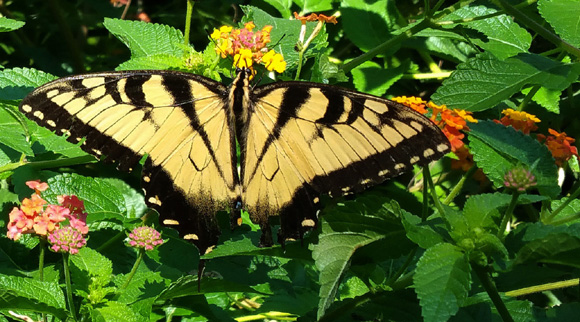The regional manager for our puppy-raising group, Laura, introduced
us to this protocol at one of our meetings in November and I've used
parts of the course with guide-puppy-in-training Don. It's a complicated
but effective way to train a puppy or dog to relax in any situation.
Don is naturally very relaxed in our home because he feels safe
there. He still loves to sprawl out on our doggie beds, in his crates,
or on the floor like this:
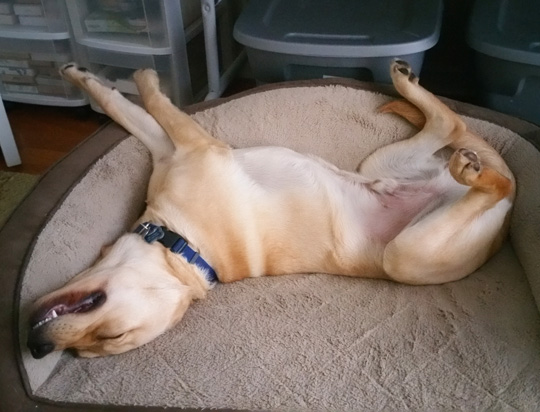
Don also quite naturally feels less secure in other environments,
especially new ones, so using this protocol with him in different
settings will hopefully reduce his stress and instill more confidence.
Here's a
link to describe this detailed
technique, which has fifteen sets of tasks that get increasingly
complicated as the dog and handler master each section. The audio
version is easier for me to follow than reading it from my phone or
printing it out from my computer. YMMV.
DAPPER DON IS EIGHT MONTHS OLD ALREADY!
And what a handsome, intelligent, sweet boy he is.
Here are some pictures from his eight-month photo shoot
in one of the new bow ties I've made him:
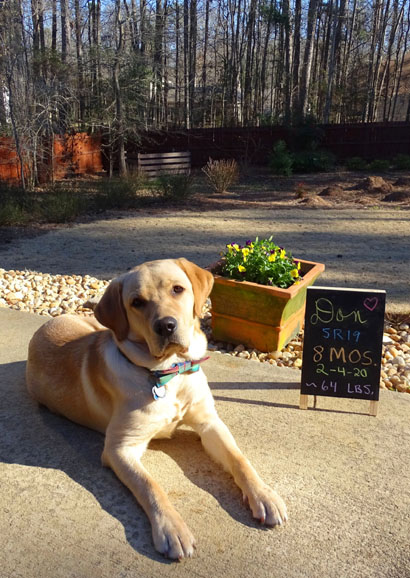
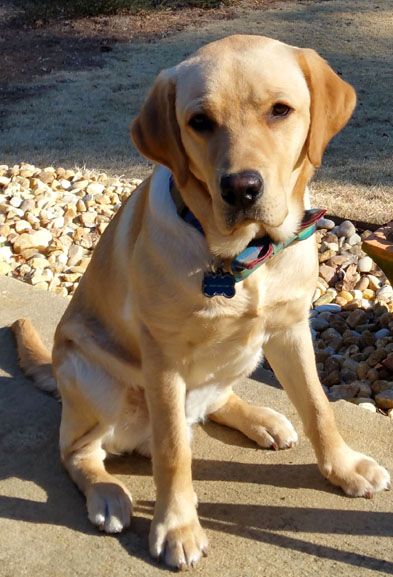
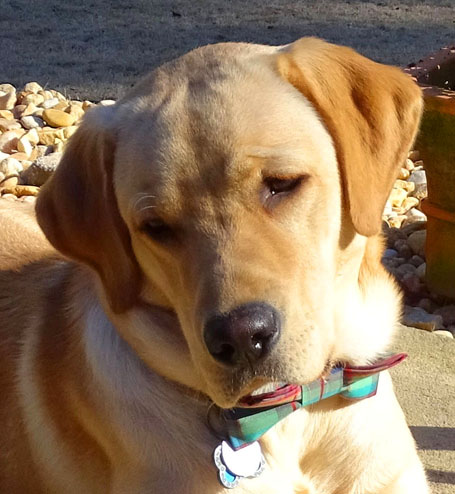
Don's rate of growth is slowing down a little. He gained just a
couple more pounds from his seven-month to his eight-month birthday.
On February 4 he was about 64 pounds.
By the end of February he had gained a little more and had outgrown his
small guide puppy vest. Our regional manager, Laura, told me
previously that we could get the larger size vest "when the
small one looks like a bikini on him."
I sent her a couple of the pictures I took of him at the Peachtree City
fountain on February 29 and asked if it looks like a bikini yet?
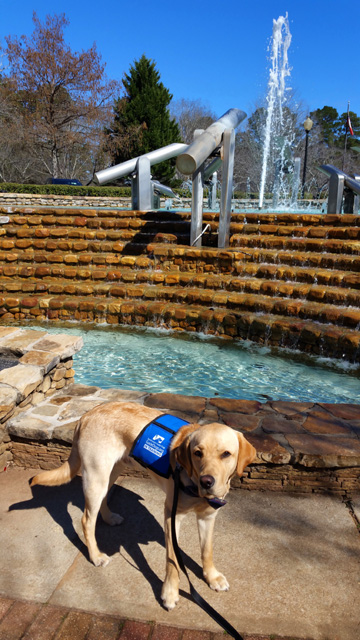
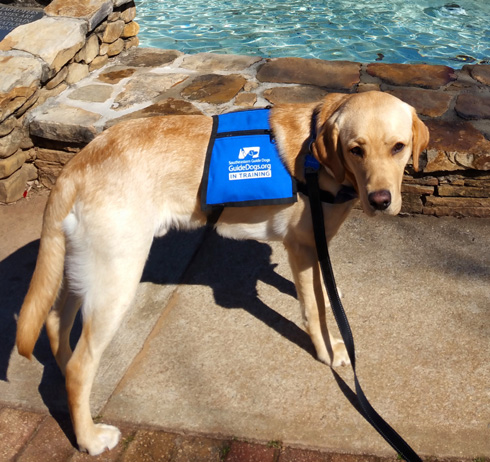
She wrote back, "No, it looks like a saddle!" Ha! We got a laugh out
of that. Don is lean and long-legged like a horse.
We never did get a larger vest for Don. Although Laura agreed that he needed one,
chaos ensued soon after this in early March with the the COVID pandemic. Our
puppy raiser group's meetings were cancelled indefinitely and other significant
changes occurred that I'll discuss in subsequent entries. A new vest was a low priority
at that point.
TRAINING & EXPOSURES
February may be short but it was long on big events for Don.
Our first puppy raiser meeting was supposed to be a tour of the Atlanta Brave's
stadium on the 8th. It was cancelled due to a winter weather advisory. Several
inches of snow fell that morning, which just about brought the metro
area to a standstill for the weekend. (No snow where we live, so the
dogs didn't get to play in any.)
Fortunately, the weather was good the next weekend when we drove to Tybee Island,
GA for the 2020 conference organized by the Savannah puppy raisers' group.
About half of the pups from our group were in attendance. We took Don, and
between the long drive there and back and all the new experiences he had, he was
one pooped pup when we got back home! He behaved perfectly but it was sensory
overload for him.
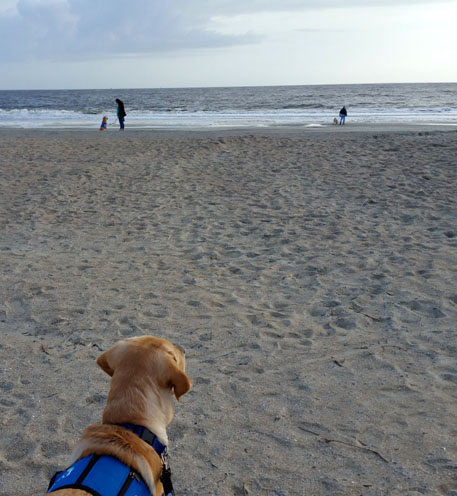
Among other big, new things, it was Don's first time
at the ocean. (Tybee Island, 2-16-20)
In retrospect, we wouldn't have taken him to the conference if we'd known how much
it would wear him out mentally and physically.
Our puppy raiser group was able to reschedule the Braves stadium tour for the
weekend after PuppyCon. Jim and I enjoyed that but Don had barely recovered from
his big adventure at Tybee Island when he was presented with another new,
in-his-face outing with no gradual exposure first. Fortunately, that outing
was for just two hours (plus another two in the car) and not three days long.
I'll have separate entries for both of those events.
UNDERSTANDING DON'S COMFORT ZONE
Don is a relatively sensitive pup who is easy to train because he wants very
much to please people. He also lacks confidence and gets more inhibited
than activated when he's under stress in new situations.
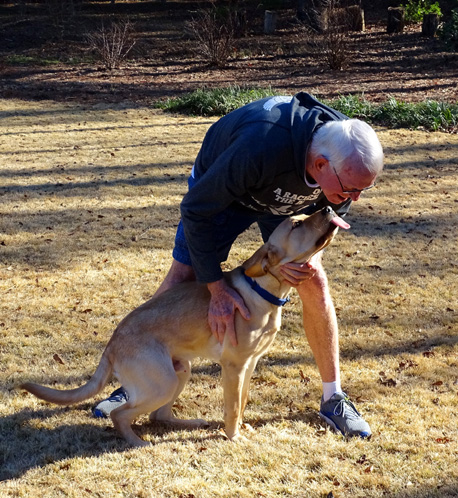
Don gives Jim some puppy kisses in the back
yard. (2-6-20)
Don's sensitive temperament has been apparent to us since we got him at 13 weeks of
age, so we've been very gentle with him. He doesn't need a heavy hand or harsh voice
to respond to training cues and exhibit good manners. Consistency, treats,
verbal praise, lots of hugging, and other positive rewards are all he needs 99%
of the time to choose appropriate behaviors.
It's taken us longer to understand when Don is under stress
instead of just being quiet and well-behaved.
RM Laura told us in puppy kindergarten to introduce him to new exposures very
gradually so until this month, we've been doing that as much as possible so
as not to overwhelm him. I think it's been working well with the places he's
gotten used to over the past six months because he loves to ride in the car and
eagerly approaches each place when we get to the parking area.
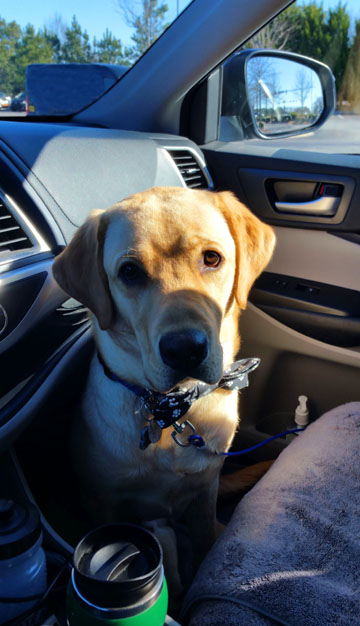
Still able to ride in front (if
there is no passenger) on 2-2-20 but
needs to ride behind the front
seats by the end of the month
However, during our puppy raiser group outings, all places that are new to Don and
with more people and other dogs, Area Coordinator Ellen has pointed out specific
behaviors she's observed that indicate both inhibition and lack of confidence --
e.g., drooling, tongue flicking, shaking his head, ears back, compressed body.
OK, I understand most of those and have seen them listed in the
puppy raiser manual and other information provided to raisers.
I have the most problem knowing when his drooling is a sign of stress because he
often drools at home when food and treats are involved (meal times, training
sessions, photo shoots, etc.), on our usual neighborhood walks (dog scents make him
drool), and in stores/other places where he likes to go (treats for appropriate behavior).
His body language in those situations is positive -- ears forward,
tail wagging, and an overall happy demeanor. If anything, he's activated then, not inhibited.
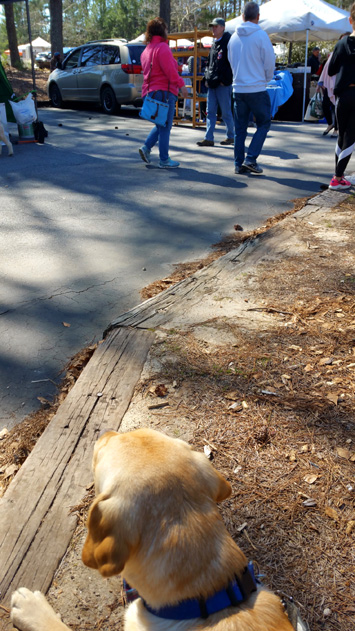
Don enjoys seeing people at the
farmers' market because I let him greet
some people there. He's a good informal ambassador for SEGD. (2-29-20)
When I told RM Laura about my confusion over when Don's drooling is a sign of stress
and when he's simply motivated by the thought of food, she suggested an interesting
experiment -- taking him to the same store four different times, in and out of coat
and with/without his treat bag.
I did this as she suggested with coat on + treats,
coat on/no treats, no coat + treats, and no coat/no treats.
Unfortunately, there were other variables that were hard to control and the experiment
wasn't conclusive. There was some drool each time -- never excessive -- and
only very subtle differences between the four combinations.
He did tend to drool slightly less with his coat on and no treats, and a little more
with no coat + treats. But it still leaves me wondering how much his drool in new
situations is related to stress and how much is related to anticipation of
treats for being a Good Boy. I do give him more treats in new situations.
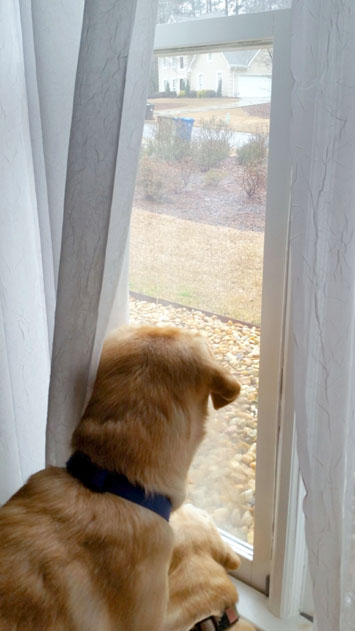
Don and Holly looking out the windows by my desk on
a rainy day
I want to continue to give Don positive reinforcement when he does what I want him to do
-- heel on a loose leash, don't scavenge on the floor, don't approach people, wait
patiently when I'm talking to someone, etc. -- and nothing is more motivating
to Don than a food treat!
The best I can do is anticipate situations where
he might be under more stress, watch him closely for signs of fear/inhibition,
and do what I can to mitigate it.
One example of that occurred part way through the Braves stadium tour when Ellen
advised me to keep Don "on the fringe" of the group and not in the middle
of it as we were following the tour guide around. I missed most of what the woman
was telling us but it did seem to lessen Don's stress by hanging at the back of the
group for the remainder of the tour.
LACKING CONFIDENCE?
As far as a lack of confidence, I usually don't see that trait in Don, either
-- maybe in some new situations, but this is the kind of confident look he
usually shows. This is one of the shots I took for his 8-month birthday:
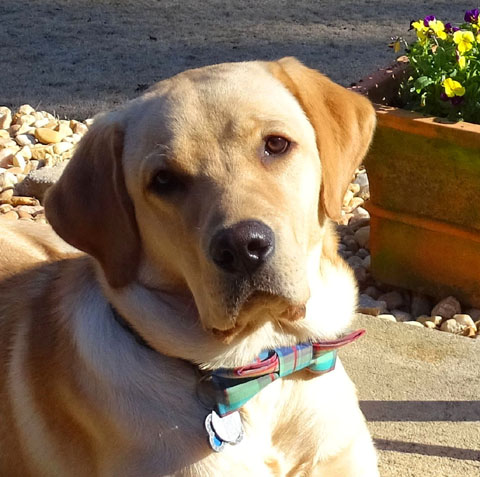
Sometimes he displays more confidence than our more experienced and exuberant girls.
For example, I got Jim a shiny helium balloon for Valentine's Day and attached it to
the wires on the top of Don's large crate between the kitchen and family room so it
hovered several feet in the air. All three of our dogs had a different reaction when
they first saw it, and not the ones I expected from each of them.
Instead of Holly barking at it like I thought she would, Casey was the one who barked.
Holly noticed the balloon, stopped for a few seconds, then tippy-toed past it as
far as she could get from it.
And Don? He was Mr. Cool, acknowledging the balloon was there but nonchalantly walking
past it without any surprise or fear. That indicated confidence and a sense of security
to me. He's also the only one of the three that not only stays in the same room when
I'm vacuuming, but doesn't move when the machine is a foot away from him!
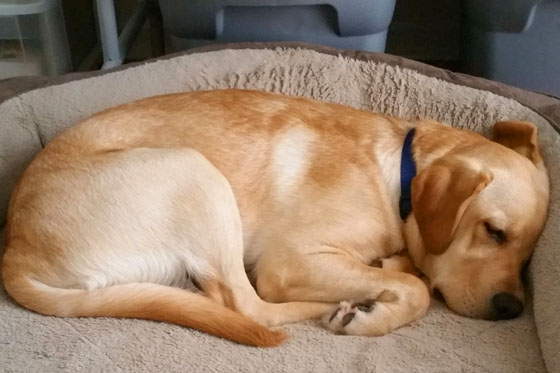
Relaxed and already filling up the large
doggie sofa bed at eight months old (2-11-20)
On the other hand, Don is still doing that stop-look-listen-sniff thing
behind me several times on each daily walk of two to four miles.
I don't know if he's being extra observant and "watching my back" or if
it's a fear reaction. He often walks by some things with no
reaction that I think would frighten him or at least arouse more
curiosity. Even noisy garbage trucks driving within a few feet of us don't
outwardly faze him. Nor do unexpected more distant noises like thunder or fireworks.
TROUBLE-SHOOTING DON'S SCENT DISTRACTION
I figured PuppyCon and the Braves stadium provided plenty of brand new exposures
for Don this month, so all of his outings with just me near home were to familiar
businesses and other places -- Home Depot, Sam's Club, Target, Pike Nursery,
TJ Maxx/Home Goods, BedBath&Beyond, Drake Field, the Saturday farmers'
market, Line Creek trails.
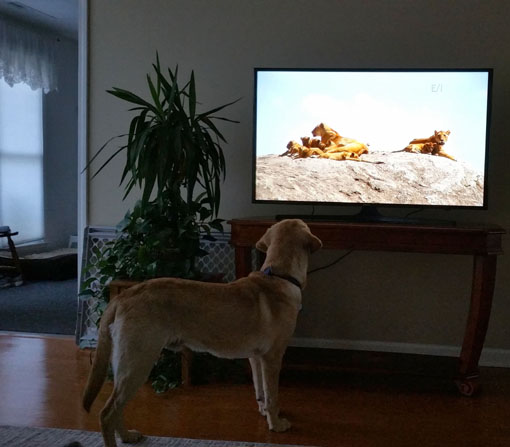
Don is fascinated by animals, especially
dogs, on TV. He was also interested
in these lions (above).
Fast-forward to September, when I got him a
lion's mane for a fun photo-shoot (below).
He's a very gentle Lion King.
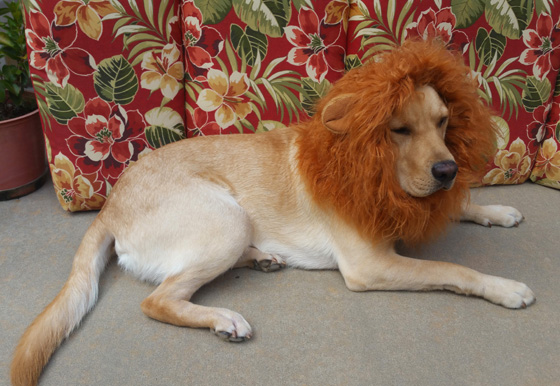
While he's a perfectly-behaved pup in those situations and walking along
residential streets, Don continues to be highly distracted by dog and
wildlife scents on our multi-use paths and trails. That's really the
only problem I've had with training him this whole time.
Laura came by one day to help me with the procedure using collar cues
that is recommended by Southeastern Guide Dogs for this problem.
We walked down our street to the nearest section of path where Don pulls
over to sniff things and she demonstrated both how to prevent Don from
doing it and how to reward him when he doesn't.
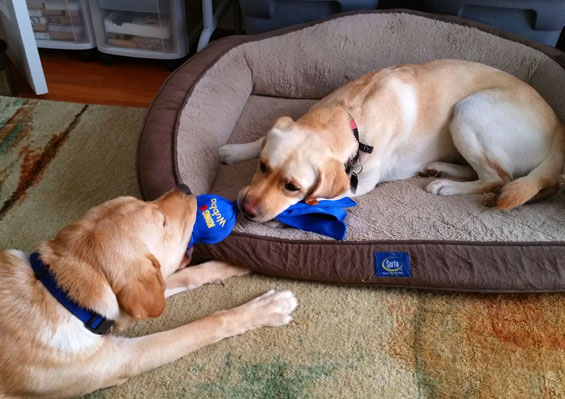
Above and below: just two pictures of
Don and Holly playing tug
with new Kong toys to break up the space in
this entry! (2-18-20)
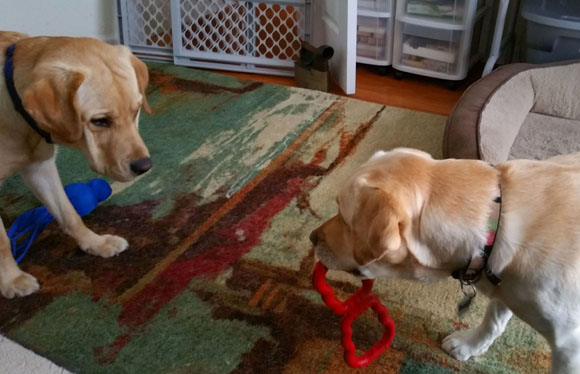
The procedure goes like this:
As Don is walking on a leash attached to his flat collar, hold the leash
about two feet above his neck (just enough slack to heel with a loose leash).
If he pulls to the left to sniff something off the path, hold the leash tight.
Don't let him reach the scent and don't pull him back. He will know from his
early collar cue training to ease off and release the pressure. When he does,
mark immediately with a verbal YES and reward him with praise and a treat.
Say "let's go." Proceed forward about ten paces, turn around, go back
past the place he wanted to sniff, turn again, come to the good-smelling spot,
say "Break," and let him sniff there for a little while. That's his reward.
Then say "let's go" and proceed forward again.
Repeat as often as needed! The puppy or dog should get the message pretty soon.
Yes, this takes time and it can be frustrating for the handler. Sometimes I've had to
either shorten the walk or just let it take more time, but this method has worked
pretty well with Don in just a few sessions.
DIETARY CHANGES
A new challenge for us this month is having to change the food Don is eating.
The problem isn't whether he'll eat the new brand of food. He's not picky. I think
he'll eat any food we give him! We just don't want a repeat of the problems
we had with loose stools the first two months we had him, and any change of diet
can potentially do that.
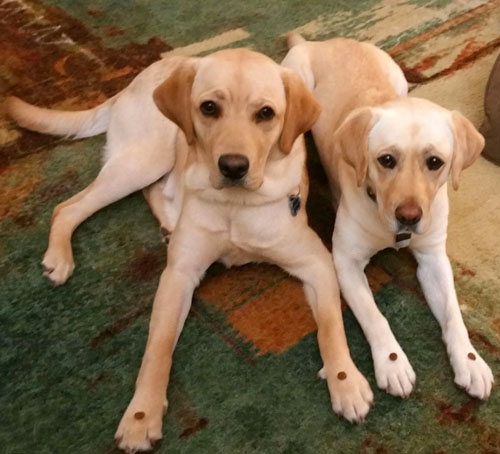
Don (L) and Holly practice impulse control with kibble on their paws.
They are both rock stars at this game, with several variations. Note
how much larger Don is (8+ months) than Holly (3 years).
(2-20-20)
SEGD and other guide and service dog schools usually have a food
sponsor and either require or encourage their puppies and dogs to eat that brand.
So do many professional breeders.
When we got Don last fall, SEGD's default puppy food was Science Diet large breed
puppy chicken & oats kibble. Although Don and his littermates were initially on a
prescription kibble when they went to raisers' homes at three months of
age, when it was gone we gradually transitioned Don to Science Diet chicken, then
lamb when the problem persisted, then finally back to chicken.
He was at least five months old before his stools were finally normal consistency.
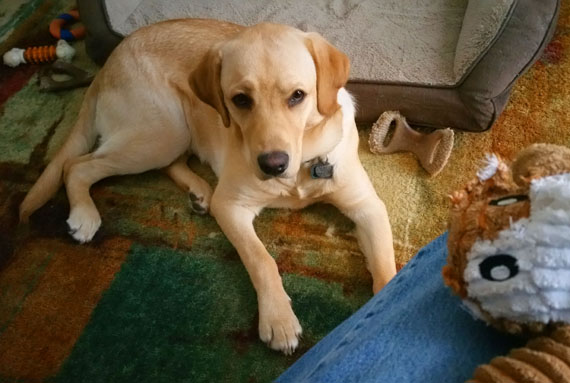
Don watches attentively as I do some
emergency surgery on one of his stuffed toys. (2-11-20)
Recently SEGD switched sponsors from Science Diet to Fromm and told the raisers to
transition to one of their specific puppy foods.
The Fromm chicken puppy food has slightly different ingredients,
is harder to find, and is significantly more expensive than Science Diet. (SEGD
puppy raisers have to pay for their pups' food, whereas some
other schools like Warrior Canine Connection pay for it.)
We weren't real happy for several reasons, but we complied. At least Fromm gave all
the raisers a coupon for a free 30# bag to start and they're providing the matched guide
and service teams with free food for the life of the working team. I assume SEGD also
gets a good discount on the food it gives the very young puppies still on
campus and the older pups in advanced training.
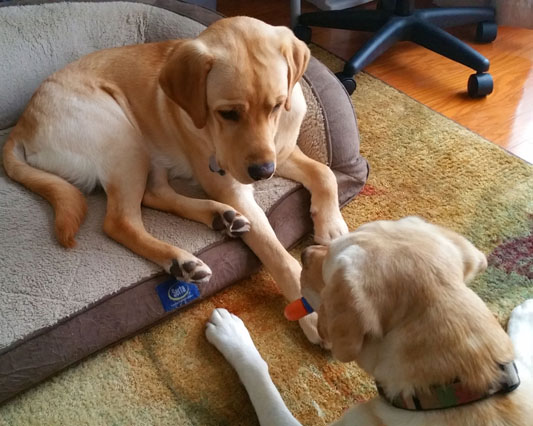
Above and below: best buddies
(2-8-20)
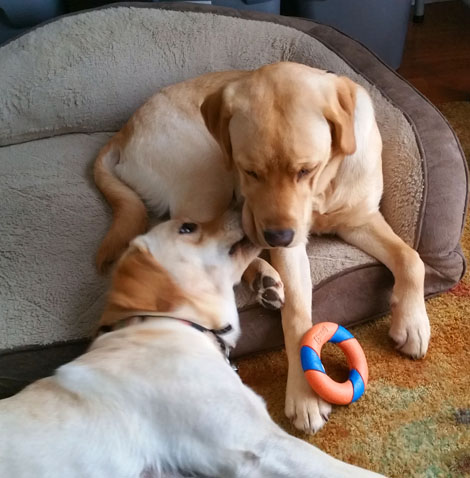
When news of the switch came to us I had just purchased (and already opened) a large bag of
Science Diet puppy food for Don. I went ahead and got the free bag of Fromm puppy
food at a local store and began mixing it very gradually with the Science Diet
kibble in mid-February.
So far, so good -- no digestive issues. He'll get a mix of both
kinds of food for several weeks until the Science Diet runs out.
We will continue to give Holly and Casey Science Diet because they do
quite well on the adult chicken version and our vet thinks it's just
fine for them.
~~~~~~~~~~~~
In summary, despite a rather stressful month for Dapper Don (I haven't even mentioned
everything yet!), he remains a cuddly Love Bug who wants nothing more than lots
of hugs from his favorite people, playtime with Holly and a few other doggie
friends, and treats for being a Good Boy!
He's a fabulous pup.
Next entry: scenes from our weekend retreat at the
Savannah PuppyCon on Tybee Island, GA
Happy trails,
Sue
"Runtrails & Company" - Sue Norwood, Jim O'Neil,
Casey-Girl, Holly-Holly, & Dapper Don
Previous
Next
© 2020 Sue Norwood and Jim O'Neil
